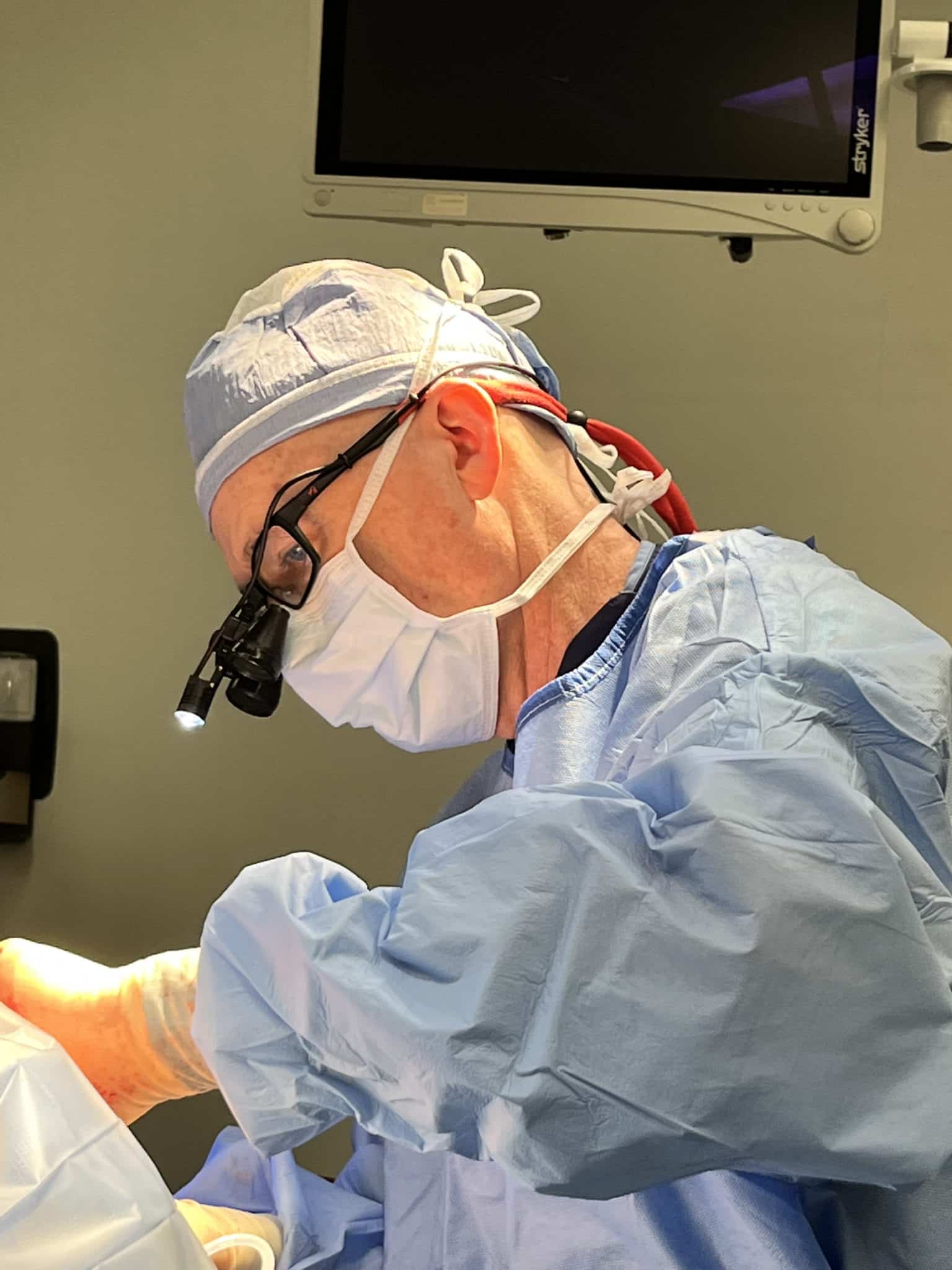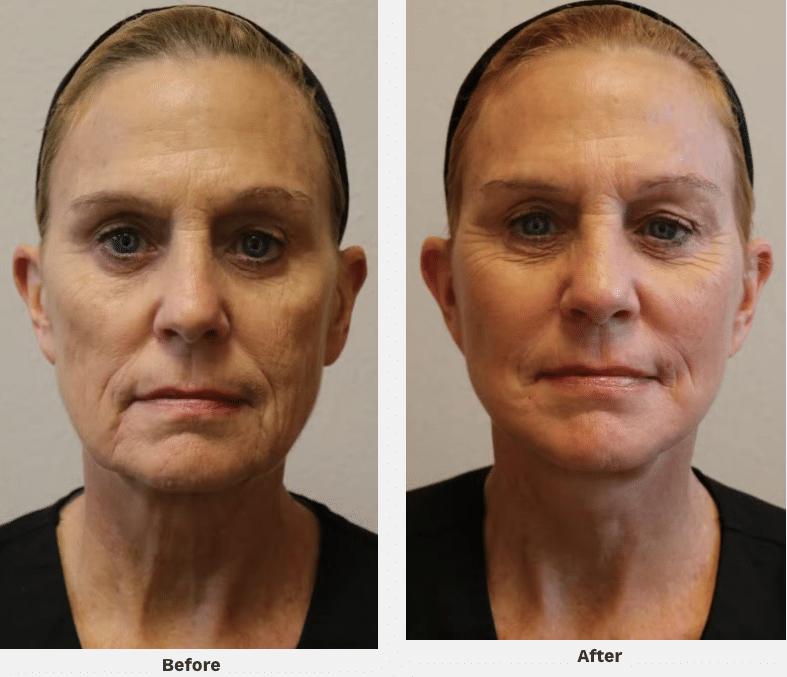Gravity, sun exposure, and the stresses of daily life take a toll on our faces and necks. Compare photographs of yourself from 10 or 15 years ago to photographs of today and you’ll notice many differences. Deeper and more noticeable creases, jowls, the face looks a little more square than oval. And what happened to the neck?!
What Is A Facelift?
Facelift surgery can alter and minimize many of the telltale signs of aging, resulting in a refreshed and rejuvenated appearance. In contrast to some of the “wind tunnel” appearance of facelifts so common in the past, a facelift performed by Dr. Kelly Kunkel tends to result in a natural, harmonious appearance. Dr. Kunkel offers facelift services to patients from Fort Worth, Colleyville, Southlake, Weatherford, Arlington, and across North Texas. Fort Worth doctors have recognized Dr. Kunkel’s outstanding care of patients and have voted him a TopDoc (Fort Worth, Texas Magazine) 22 times!
Best Candidates For A Facelift
Facelifts (technically known as rhytidectomies) rejuvenate the mid- to lower face and neck. Facelifts are most effective for patients who want to correct:
- Loose skin of the cheeks and lower face
- Deep creases between the nose and mouth (nasolabial folds)
- Jowls
- Loose skin and vertical bands in the neck

The best candidate for rhytidectomy surgery is in good health, does not smoke, is close to her (or his) ideal body weight, and has facial and neck changes like those listed above.
Facelift Combined With Other Procedures
Facelifts are frequently combined with additional procedures. Cosmetic eyelid surgery, brow lifts, and chin implants for instance, are commonly combined with rhytidectomy. Other combinations are possible, including breast augmentation, breast lift, and other body contour procedures.
What do I need to do to prepare for a facelift?
A facelift with Dr. Kunkel is major surgery, so you’ll need to prepare as you would for any surgery. This means we’ll have you stop taking blood thinning medications, aspirin, and most herbal supplements one week before your surgery. These increase the risk of excessive bleeding, which also leads to greater subsequent bruising. If you smoke, you’ll need to stop for at least two months before and two months after your surgery. Smoking constricts the blood vessels and can negatively impact your healing.
Much of your preparation should be for the early part of your recovery. No matter the facelift method and approach used by Dr. Kunkel, there will be some significant tissue repositioning. You will have swelling and bruising that will be noticeable for three to six weeks. For the first few days after your surgery you’ll need to lay low. So, you want to create your recovery nest, complete with lots of blankets and all the entertainment you may desire. You’ll need to sleep with your head elevated and you can’t sleep face-down for over a month, so the pillows will need to be positioned to help keep you from turning onto your sides or tummy.
You’ll also want to enlist some help with meals and any household needs. This isn’t the time to be the lone ranger. As for work, you’ll need to plan to miss at least two or three weeks.
How Is A Facelift Performed?
Dr. Kunkel typically performs facelift procedures in a surgery center or hospital in Fort Worth, Texas. While many patients spend the night in the facility, some desire to go home the day of the surgery. Staying overnight has the benefit of receiving great care from trained nurses, rather than relying on someone at home who isn’t sure what’s going on. However, if you have a good care system at home, going home is also fine.
How Long Does A Facelift Procedure Take?
The procedure takes Dr. Kunkel 4 to 5 or 6 hours, depending on what the patient desires and the combinations of surgery involved.
Does a Facelift Require Anesthesia?
Dr. Kunkel performs facelift surgery with the patient being put to sleep under general anesthesia. The surgery is performed in a Fort Worth hospital or ambulatory surgery center.
The Different Types Of Facelift Procedures
Each facelift is designed with a patient’s unique goals and physical attributes in mind. Some of the options are listed below.
Full Facelift
A full facelift performed by Dr. Kunkel includes treatment of the cheeks, jawline, and neck. Typically this involves making an incision just behind the hairline in the temple. The incision extends down to in front of the ear, then around behind the ear and into the hair behind the ear. An incision may also be made just below the chin. The tissues beneath the skin are lifted and tightened with sutures. As those tissues are re-positioned, redundant skin is removed. This type of facelift works best for a person who has loose neck skin, jowls, and loose skin in her cheeks.

Short Scar Facelift
This type of facelift may work best for a woman in her 40’s or 50’s who is noticing some loose skin along her jawline and neck, and maybe a little jowl development. She may say something like, “My mother had this and then developed saggy skin and jowls. I don’t want to look like that”. In a short scar facelift an incision is made just behind the hairline in the temple. The incision extends down to the ear and around the earlobe, typically ending in the crease behind the ear. Often an incision is not made in the neck.

Facelift With Fat Grafting
Dr. Kunkel often does fat grafting during facelift surgery. A small amount of fat may be easily obtained from a woman’s abdomen or thighs through one or two small incisions. The fat may be placed in the cheeks, nasolabial folds, eye brows, creases below the corners of the mouth…almost anywhere in the face! Fat grafting allows subtle facial contour enhancements, similar to having Juvederm or Restylane injections but lasting longer.

What are the advantages of a surgical facelift versus a liquid facelift?
You’ve probably heard radio ads when traveling around the Dallas/Ft. Worth metroplex touting liquid facelifts, where dermal fillers are used in lieu of surgery. You’ll hear claims from certain practices or med spas promising an equal amount of rejuvenation from a liquid facelift.
Truthfully, however, there really isn’t any comparison in the level of rejuvenation between these two procedures. Yes, dermal fillers are excellent for restoring volume to cheeks, lips, and nasolabial folds. But for patients with who have loose skin, jowls, and neck banding, a surgical facelift is really the only answer.
Surgical facelifts with Dr. Kunkel help create a refreshed, rejuvenated look. Less sagging skin, no more jowls, and fewer neck bands can make such a difference!
Liquid facelifts are best for patients with only limited sagging. They last about 6 months to one year and then additional sessions will likely be necessary to maintain your results.
What is Recovery like After Facelift Surgery?
Dr. Kunkel typically places two drains beneath the skin during surgery. A gauze dressing is applied. Many patients spend the first night in the surgical facility. Dr. Kunkel has patients go by his office the next day. During that visit they are shown how to take care of the surgical sites.
The drain tubes are usually removed in 1 to 3 days. Hair may be washed beginning the day after surgery. Patients are provided with compression garments to wear on their face and neck for two to four weeks. Sutures are typically removed 5 to 7 days after surgery. Make-up may be worn beginning about 10 days after a facelift.
The facial skin feels tight and numb for a few weeks. The face will be swollen and may have bruising that is noticeable for 3 to 4 weeks. After 3 to 4 weeks other people may not notice the swelling and bruising, but the tight and numb feelings persist. Many people take two or three weeks away from their routine activities.

Is recovery after a facelift overly painful?
Most patients do not have much pain after surgery. However, it does feel odd. The facial skin is numb for a few months, and it feels like someone placed a mask on you. The tissues feel tight because, well, they are. At least for a while. The tightness diminishes over the first couple of months as swelling decreases.
"I had a procedure with Dr. Kunkel in March of 2020 and every aspect of my experience surpassed expectations. From my first appointment to discuss the surgery, to working with Dr. Kunkel’s team to schedule, and all of my post-surgical care, I can’t say enough about how much I appreciate this practice. All of my questions were answered thoughtfully and thoroughly and I knew exactly what to expect from start to finish. I can’t say enough about Dr. Kunkel and I am thrilled with my results. Kirsten and Amy were especially helpful to me and I appreciate both of them. Considering that my procedure took place at the beginning of the COVID-19 shutdown, I appreciated that the office was proactive and ensured that I knew what to expect for each appointment. I’m extremely grateful to have found this practice and I highly recommend Dr. Kunkel!"
When will I be able to exercise after my facelift?
After major surgery like a facelift, most patients want to get their blood moving again and get back to their exercise routine. But you need to be patient — exercising too soon after a facelift can lead to complications and lead to a longer recovery.
For the first few days of your recovery, you should just walk around the house. After a few days, you can walk around the neighborhood if you want. But you don’t want to increase your heart rate or blood pressure too much, as this can cause the tiny blood vessels beneath the skin of the face to bleed.
For the remainder of the first month, activity levels can increase slowly, but heavy lifting, weight training, and any strenuous exercise needs to be avoided. Even bending over can be a problem. You need to keep your facial blood pressure down.
Four weeks after surgery, you can add light cardio exercise back to your routine, things like slowly pedaling a stationary bike or light aerobics. At six weeks, you can usually return to all exercise, including weight training and strenuous exercise. This can vary from patient to patient, however, depending on how they are doing overall.
What can I expect from my results with a facelift?
Facelifts with Dr. Kunkel have the goal of restoring a refreshed appearance. This includes minimizing sagging tissues in the lower face and neck and improving vertical bands in the neck. Who couldn’t do with some of that?

How can I maintain the results from my facelift?
The best thing you can do to make your results endure is to protect your skin from the sun and the elements. That’s especially true in the sunny Dallas/Fort Worth/North Texas area. Sun damage not only creates telltale sun spots and other areas of pigmentation, but it helps to break down collagen in the skin, causing more sagging and looseness. This is exactly what Dr. Kunkel has targeted with your facelift. When you’re out in the sun, wear protective clothing and sunscreen that has at least a 30 SPF rating.
Exercise and eating a healthy mix of foods also helps keep your skin looking its best, which keeps your overall facelift looking great as well.
How Long the Effects of A Facelift Last
The skin and tissues that remain after a facelift still have the same genetic characteristics they had before the surgery. Because of this, some stretching will occur over time. It is possible that a person may want to have another procedure in five or ten years, but this is not common.
Risks Of Facelift Surgery
Every surgical procedure includes risks. All operations, from hernia repairs to tummy tucks to facelift surgery include risks of infection, bleeding, blood clots, and poor healing. Risks more unique to rhytidectomy include loss of feeling of facial skin, localized problems with movement of parts of the face, asymmetry of the result, and hair loss.
How Much Does Facelift Surgery Cost?
The prices listed here include Dr. Kunkel’s fee, the surgical facility fee, and the anesthesia fee. Prescription medications cost extra. Insurance may pay the majority of the costs of the medications but that varies by insurance company. The costs of facelift surgery will vary, depending on a person’s unique physical attributes, what she hopes to achieve, and the length of the procedure.
- Facelift alone, no other procedures: approximately $16,950.
- Facelift with fat grafting: approximately $20,000+.
- Facelift with cosmetic upper eyelid blepharoplasty surgery: approximately $22,650.
- Facelift with cosmetic lower eyelid blepharoplasty surgery : approximately $23,500.
Schedule A Consultation
To learn more about our Facelift procedures, call us at 817.335.5200 to schedule a consultation. Our practice serves Fort Worth, TX, and the surrounding areas.
